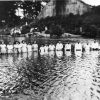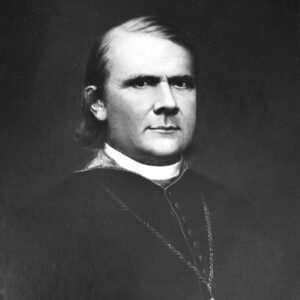calsfoundation@cals.org
Andrew Byrne (1802–1862)
Andrew Byrne was the first Roman Catholic bishop of the Diocese of Little Rock, which then and now encompasses the boundaries of the entire state of Arkansas. A prelate on the southern frontier, he had few Catholics in his ecclesiastical domain; nevertheless, he planted the Church so deeply that even his death, the Civil War, and the five-year absence of any bishop could not eradicate the faith.
Andrew Byrne was born in Navan, a town about forty miles northwest of Dublin, Ireland, the son of Robert and Margery Moore Byrne. There is no exact date of his birth on parish records, though they record that he was baptized on December 3, 1802; with his name being Andrew, he may have been born on November 30, the Catholic feast day for St. Andrew the Apostle. While a seminarian in Navan, he heard Bishop John England of Charleston, South Carolina, in a personal appearance at the seminary, asking for priests for his new American diocese. Answering the call, Byrne arrived in Charleston in the early 1820s. He completed his formation under Bishop England, who ordained him to the priesthood on November 11, 1827.
After first serving in North Carolina, Byrne became pastor of St. Mary’s Church in Charleston by 1830. In 1833, he accompanied Bishop England to Baltimore to the Second Provincial Council as the Vicar General for the Diocese of Charleston. For reasons unknown, Byrne left the Diocese of Charleston in 1836 and transferred to the Diocese of New York, where he distinguished himself as a preacher-pastor; acting as the founding pastor of St. Andrew’s Church in New York City in 1842.
Byrne’s abilities as pastor, his prior experience in the South, and a recommendation from Bishop John Hughes of New York made him an obvious choice for a new diocese on the southwestern frontier. After Pope Gregory XVI erected the Diocese of Little Rock on November 28, 1843, Byrne was consecrated as Arkansas’s first Catholic bishop on March 10, 1844, at the Old St. Patrick’s Cathedral. He arrived in Little Rock (Pulaski County) three months later, with just two other priests to minister to all of Arkansas.
Byrne quickly discovered that there was a Catholic church already built in Little Rock at northwestern corner of 7th and Louisiana, but the priest who had built it had taken the deed to the property and sold it to another priest in New Orleans. Byrne eventually acquired title to this land on August 13, 1851. By that time, he had raised funds to purchase a lot at 2nd and Center streets in Little Rock, where he erected and dedicated the first Cathedral of St. Andrew on November 1, 1846.
Throughout his eighteen years as Arkansas’s Catholic prelate, he never had more than ten priests working under him. He maintained the diocese with funds primarily from Austrian-based Leopoldine Society and the French-based Society for the Propagation of the Faith. From these and other funds, Byrne bought land and started the College of St. Andrew, a Catholic institution near present-day Fort Smith (Sebastian County). He traveled to Naas, Ireland, to persuade the Sisters of Mercy to locate a convent in Little Rock. In 1851, the sisters opened what was then known as the Academy of St. Mary (now Mount St. Mary Academy), the oldest continuous educational institution in the state of Arkansas. By the start of the Civil War, the Mercy sisters had opened convent academies in Fort Smith and Helena (Phillips County).
During the nativistic, anti-Catholic Know Nothing uproar, Byrne studiously avoided political disputes. He never owned slaves, and his correspondence reveals no opinion on the issue. Like most southern Catholic prelates, Byrne probably saw slavery as political issue, not one of moral or religious concern. In 1850, the Diocese of Little Rock was attached to the newly created ecclesiastical province of New Orleans. With bishops from Mississippi, Alabama, Texas, and northern Louisiana, Byrne attended provincial councils in New Orleans in 1856 and 1860.
Byrne worked diligently to attract Catholic immigrants and clergy to Arkansas, especially from his famine-stricken birthplace, Ireland. Still, by 1860, Catholics still numbered just one percent of the white population, and less than one half of one percent of the total population. The Civil War closed his College of St. Andrew in 1861 and disrupted international communications, making it difficult for the Arkansas bishop to secure needed funds from Europe.
Byrne died in Helena on June 10, 1862, at St. Catherine’s Convent, exhausted from his missionary labors in a poor diocese on the southern frontier. He was buried initially in the Mercy Sisters convent garden in Helena, but Bishop Edward M. Fitzgerald, his successor, had his remains placed in crypt in his new Cathedral of St. Andrew in Little Rock on November 30, 1881.
For additional information:
Archives of the Archdiocese of New Orleans. Old Ursuline Convent, New Orleans, Louisiana.
Archives of the Diocese of Little Rock. St. John’s Catholic Center, Little Rock, Arkansas.
“Death of Bishop Byrne.” Arkansas Gazette. June 28, 1862, p. 2.
Woods, James M. Mission and Memory: A History of the Catholic Church in Arkansas. Little Rock: August House, 1993.
James M. Woods
Georgia Southern University
 Louisiana Purchase through Early Statehood, 1803 through 1860
Louisiana Purchase through Early Statehood, 1803 through 1860 Religion
Religion Andrew Byrne
Andrew Byrne 




Comments
No comments on this entry yet.